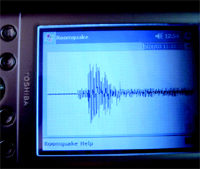Embedding Dynamic Phenomena within the Physical Space of an Elementary School Classroom
April 2nd, 2005
Categories: Applications, Education, Human Factors, Visualization

Authors
Moher, T., Hussain, S., Halter, T., Kilb, D.About
Authentic practice in science requires access to phenomena. In this paper, we introduce RoomQuake, an application designed to foster the growth of a community of learning around scientific practice in seismology. Rather than treating seismic activity as remote events, RoomQuake seeks to enhance salience by situating those phenomena directly in the classroom. Using fixed-position PDAs as simulated seismographs, students determine the magnitude and distance of a series of “randomly” timed events by reading characteristic waveforms and using calibrated tape measures to sweep out arcs from multiple stations until they literally collide, physically enacting mathematical trilateration. We describe our experience in a six-week unit iin a fifth-grade classroom.
Author Keywords: Learning technologies, simulation, embedded phenomena
ACM Classification Keywords: H.5.3 Group and Organization Interfaces; K.3.1 Computer Uses in Education
Resources
Citation
Moher, T., Hussain, S., Halter, T., Kilb, D., Embedding Dynamic Phenomena within the Physical Space of an Elementary School Classroom, ACM Conference on Human Factors in Computing Systems (CHI 2005) Extended Abstracts, Portland, OR, pp. 1665-1668, April 2nd, 2005.